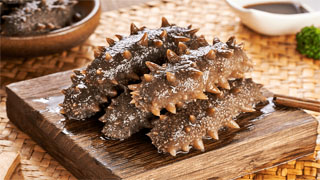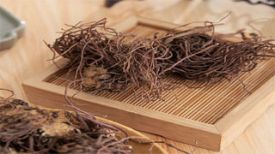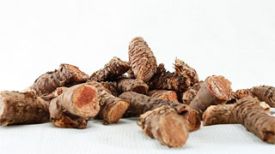
1. Aliases
Liaoshen, a sea man.2. Animal morphology
Sea cucumber: It is cylindrical in shape, generally 20-40 centimeters long and 3-6 centimeters wide, with a raised back and 4-6 rows of cone-shaped flesh spines of varying sizes. The ventral tube feet are dense and arranged in irregular longitudinal bands. The mouth is in the front end and the back end is the anus. The mouth is inclined towards the abdomen, with 20 viper shaped tentacles around it. There is a mastoid process on the back of the mouth, and the reproductive foramen is located at the process. The bone fragments inside the skin are mainly in the form of a table. For young individuals, the table shaped tower is thin and high, with a larger base and smooth edges. For older individuals, the table shaped tower becomes lower or disappears, leaving only a small perforated plate. The spawning season is from the end of May to early July. During daily life, the body color is usually chestnut brown, and there are also green, yellow brown, gray white, etc., which vary depending on the habitat.
Green sea cucumber: Its body is square and cylindrical, usually over 30 centimeters long, with two rows of cone-shaped flesh spines arranged alternately along the edges of its body. There are many ventral tubules arranged in three longitudinal bands, with a wider central band. The mouth is slightly inclined towards the abdomen, with 20 tentacles. The bone fragments in the superficial layer of the skin are mainly a slightly square table shape, with slightly outward expansion above, and 8-12 small teeth on the top, up to a maximum of 16; The lower chassis is small with 4-8 perforations. The bone fragments within the deep skin are small C-shaped. In daily life, the body color is dark green or dark green, the top of the flesh spines is orange yellow or orange red, the base of the tentacles is gray white, and the legs are black gray.
Flower Sea Cucumber: The body is slightly square and columnar, usually 30-40 centimeters long, and can reach a maximum length of 95 centimeters. On the back, there are many cone-shaped and irregularly arranged flesh spines scattered. The ventral peduncle is arranged in three longitudinal bands, with a wider central band. 20 tentacles. Skin bone fragments: The first type is a table shape, with 12 outward expanding small teeth at the top of the tower. Its base is small and slightly square, with 4 large holes in the center and 4 or more small holes around it; A table with a larger chassis has more small holes around it. The second type of bone fragments are C-shaped structures of varying sizes. The third type is a patterned specimen composed of several C-shaped connections. During daily life, there is a significant variation in body color, mostly olive green and gray, with occasional gray yellow, light brown, and dark green spots or markings, and some flesh spines have a reddish end. The spawning season is in late June.
3. Origin distribution
Sea cucumbers: They mostly inhabit shallow waters with a depth of 3-15 meters, preferring stable waves and seaweed on rocky reef bottoms or fine sand and mud bottoms. China is distributed in shallow waters along the coasts of Liaoning, Hebei, and Shandong. It has now been artificially bred and released for free range. Green sea cucumber: inhabits coral sand with seaweed or inside coral reefs; Or in a lagoon washed away by seawater. China is distributed in the south of Hainan and the Xisha Islands. Flower sea cucumber: mostly inhabits intertidal coral reefs or under rocks, with larger individuals often found in deeper waters. China is distributed in coastal shallow waters such as Hainan, Leizhou Peninsula and the Xisha Islands.
4. Harvesting and processing
Divers often go underwater to catch fish in spring and autumn, and can also use trawl fishing, but it causes significant resource damage and is often prohibited. After catching, remove the internal organs, wash the sediment and blood stains inside the cavity, boil in salt water for about 1 hour, then remove and let cool. After being exposed to sunlight or baked until it reaches 80-90%, add it to the pomelo juice and cook slightly until the color turns black. Take it out and let it dry. It has a salty and fishy taste.
5. Characteristics of medicinal herbs
The medicinal herbs are cylindrical or square in shape, with slightly thinner ends. Divide the body into two sides: the back and abdomen. The back is raised with 4-6 rows of cone-shaped flesh spines. The abdomen is relatively flat with dense small protrusions, and there are suction cups at the end. There are 20 tentacles around the mouth. Some are missing and wrinkled. The anus is located behind the body and slightly off the back. Body black, purple black, gray black, gray brown, light yellow or yellow brown.
6. Nature, taste, and meridian tropism
Mild in nature, sweet and salty in taste. Return to the Kidney Meridian and Lung Meridian.
7. Effect and function
Tonify the kidney and essence, nourish blood and moisten dryness, and stop bleeding. Blood tonifying drugs classified under the category of tonifying deficiency drugs.
8. Clinical applications
Internal administration: decoct soup, cook food, dosage 15-30 grams; Take pills and powders, with a dosage of 9-15 grams. External use: Apply with grinding powder. Indications include loss of essence and blood, weakness and fatigue, impotence, nocturnal emissions, frequent urination, intestinal dryness and constipation, lung deficiency, cough and hemoptysis, intestinal wind and rectal bleeding, and external bleeding.
9. Pharmacological research
1. Sea cucumber extract has inhibitory effects on human gastric cancer MGC-B01, human liver cancer BEL-7402, and lung adenocarcinoma SPC-A in vitro, but has no significant effect on normal cells. Both sea cucumber extract and sea cucumber polysaccharides can significantly prolong prothrombin time and have anticoagulant effects. The analgesic effect of 1 milliliter of sea cucumber extract is approximately equivalent to the analgesic effect of 1 milligram of morphine. 4. Sea cucumber extract exhibits a concentration dependent sustained contractile effect on rabbit arteries. 5. The extract of sea cucumber alcohol has a significant induction and activation effect on the T4 and T8 cell subsets of T regulatory cells in nasopharyngeal carcinoma (NPC) patients in vitro. 6. Anti fungal effect: Sea cucumber toxin has a significant inhibitory effect on fungi such as Aspergillus and Candida albicans. 7. Anti radiation damage: Acidic mucopolysaccharides from sea cucumber have the effect of preventing and treating acute radiation damage, and can significantly promote the recovery of hematopoietic function in experimental animals.
10. Chemical composition
Sea cucumber contains protein, fat, carbohydrates, calcium, phosphorus, iron, magnesium, selenium, as well as vitamins B ₁ and B ₂. Green sea cucumber contains 18 types of amino acids, taurine, chondroitin sulfate, and other components. Sea cucumber contains components such as sea cucumber extract, sea cucumber saponins, acidic mucopolysaccharides, sterols, terpenoids, beta carotene, sea urchinone, astaxanthin, and zeaxanthin.
11. Taboos for use
Those with spleen deficiency and incomplete external evil are prohibited from taking medication.
12. Compatibility prescription
① Treatment for weak and soft body, frequent urination: 30g dried sea cucumber, soaked in water until soft, stewed or served in soup with lean pork or chicken. (Guangxi Medicinal Animals)
② Treatment of diabetes: 3 sea cucumbers, 1 egg, 1 pig pancreas, 6 grams each of Kochia scoparia and sunflower stem. Steam the first three ingredients until cooked, then add the water decoction of the last two ingredients and cook together for internal consumption. (Chinese Journal of Medicinal Marine Organisms)
③ Treating deficiency fire and dryness: sea cucumber and black fungus (cut to pieces). Cook and eat in the pig's large intestine. (Food Examination)
④ Treating hypertension and vascular sclerosis: 30g sea cucumber, appropriate amount of rock sugar. Cook until cooked, take on an empty stomach daily. (Food, Traditional Chinese Medicine, and Stool Formula)
The content of the article is for clinical reference only. Non professionals in traditional Chinese medicine are not allowed to try medication.


